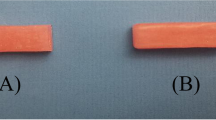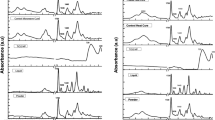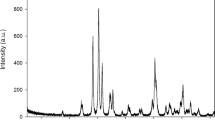Abstract
Poly methyl methacrylate (PMMA) resin is the most widely used material for fabrication of dentures since 1937 as it exhibits adequate physical, mechanical and esthetic properties. But one of the major problems faced using this material is that, it is highly prone to plaque accumulation due to surface porosities and its food retentive properties. This in turn increases the bacterial activity causing denture stomatitis. In efforts to impart antimicrobial property to these resins, various nanoparticles (NP) have been incorporated viz. Silver, Zirconia oxide, Titanium dioxide (TiO2), Silica dioxide (SiO2) etc. However, as additives they can affect the mechanical properties of the final product. Therefore, the aim of the present study was to evaluate and compare the effect of different concentration of TiO2 NP on the flexural strength of PMMA resins. Specimens made from heat polymerizing resin (DPI) without NP were used as a control group (Group A). The two experimental groups, (Group B and Group C) had 0.5 and 1 % concentration of TiO2 NP respectively. The specimens were stored in 37 °C distilled water for 50 ± 2 h. A three-point bending test for flexural strength measurement was conducted following ADA specification no. 12. The maximum mean flexural strength (90.65 MPa) belonged to the control group; and acrylic resin with 1 % TiO2 NP demonstrated the minimum mean flexural strength (76.38 MPa). But, the values of all the three groups exceeded the ADA Specification level of 65 MPa. Conclusion may be drawn from the present study that addition of TiO2 NP into acrylic resin can adversely affect the flexural strength of the final product and is directly proportional to the concentration of NP.





Similar content being viewed by others
References
Dhir G, Berzins DW et al (2007) Physical properties of denture base resins potentially resistant to candida adhesion. J Prosthodont 16:465–472
Nam KY, Lee CH, Lee CJ (2012) Antifungal and physical characteristics of modified denture base acrylic incorporated with silver nanoparticles. Gerodontology 29:e413–e419
Shibata T, Hamada N et al (2007) Antifungal effect of acrylic resin containing Apatite-coated TiO2 photocatalyst. Dent Mater J 26:437–444
Allaker RP (2010) The use of nanoparticles to control oral biofilm formation. J Dent Res 89:1175–1186
Mu R, Xu Z, Li L, Shao Y, Wan H, Zheng S (2010) On the photocatalytic properties of elongated TiO2 nanoparticles for phenol degradation and Cr(VI) reduction. J Hazard Mater 176:495–502
Pant HR, Pandeya DR, Nam KT, Baek WI, Hong ST et al (2011) Photocatalytic and antibacterial properties of a TiO2/nylon-6 electrospun nanocomposite mat containing silver nanoparticles. J Hazard Mater 189:465–471
Sodagar A, Bahador A et al (2013) The effect of TiO2 and SiO2 nanoparticles on flexural strength of poly(methyl methacrylate) acrylic resins. J Prosthodont Res 57:15–19
Revised American Dental Association Specification No. 12 for denture base polymers
Anusavice KJ (2003) Philip’s science of dental materials, 11th edn. W.B. Saunders, St. Louis, p 721
Dills SS, Olshan AM, Goldner S, Brogdon C (1988) Comparison of the antimicrobial capability of an abrasive paste and chemical-soak denture cleaners. J Prosthet Dent 60:467–470
Kanno T, Nakamura K, Ikai H, Hayashi E, Shirato M, Mokudai T, Iwasawa A, Niwano Y, Kohno M, Sasaki K (2012) Novel denture-cleaning system based on hydroxyl radical disinfection. Int J Prosthodont 25:376–380
Pisani MX, Bruhn JP, Paranhos HF, Silva-Lovato CH, de Souza RF, Panzeri H (2010) Evaluation of the abrasiveness of dentifrices for complete dentures. J Prosthodont 19:369–373
Moore TC, Smith DE, Kenny GE (1984) Sanitization of dentures by several denture hygiene methods. J Prosthet Dent 52:158–163
Lainovic T, Blazic L, Potran M (2012) Nanotechnology in Dentistry-current state and future perspectives. Serb Dental j 59(1):44–47
Hajipour MJ, Fromm KM et al (2012) Antibacterial properties of nanoparticles. Trends Biotechnol 30(10):499–511. doi:10.1016/10j.tibtech.2012.06.004
Gupta K, Singh RP, Pandey A, Pandey A (2013) Photocatalytic antibacterial performance of TiO2 and Ag-doped TiO2 against S. aureus. P. aeruginosa and E. coli. Beilstein J. Nanotechnol. 4:345–351
www.ecoquest.cl/tio2%20photocatalysis%20technonews%20japan.pdf
Elsaka SE, Hamouda IM, Swain MV (2011) Titanium dioxide nanoparticles addition to a conventional glass-Ionomer restorative: influence on physical and antibacterial properties. J Dent 39(9):589–598
Han Y, Kiat-amnuay S, Powers JM, Zhao Y (2008) Effect of nano-oxide concentration on the mechanical properties of a maxillofacial silicone elastomer. J Prosthet Dent 100:465–473
Ahmad R, Sardar M (2013) TiO2 nanoparticles as an antibacterial agents against E. coli. Int J Innov Res Sci Eng Technol 2(8):3569–3574
Sodagar A et al (2012) Effect of silver nano particles on flexural strength of acrylic resins. J Prosthodont Res 56(2):120–124
Author information
Authors and Affiliations
Corresponding author
Rights and permissions
About this article
Cite this article
Nazirkar, G., Bhanushali, S., Singh, S. et al. Effect of Anatase Titanium Dioxide Nanoparticles on the Flexural Strength of Heat Cured Poly Methyl Methacrylate Resins: An In-Vitro Study. J Indian Prosthodont Soc 14 (Suppl 1), 144–149 (2014). https://doi.org/10.1007/s13191-014-0385-8
Received:
Accepted:
Published:
Issue Date:
DOI: https://doi.org/10.1007/s13191-014-0385-8




